3R Mstation HT-1100 (cont’d)
To begin the installation of our test bed, we first attached the mounting plate to our modular power supply, and then secured the plate with an attached PSU to the exhaust duct with two screws.
Compared to other cases in this roundup, this power supply install was just as easy, but unfortunately, if any switches are on the back your power supply, as is the case with ours, they will be virtually inaccessible once the unit is installed. We were able to put our MadDog unit in “quiet mode” by barely removing the supply (enough to push the switch with a thin screwdriver) while the unit was running, but it wasn’t a “user friendly” move by any means.
Other than our side-mounted IDE channel, the full-size ATX board fits without any problems. One snarl that we did run into, however, was that we had to remove the single 70mm exhaust fan before the motherboard could be laid down. This probably wouldn’t have been an issue had we installed the motherboard before the other components, but it wasn’t that big of a deal anyway.
The final steps of installing our video card and connecting all the cables were easy enough, thanks to the familiar layout and abundant space inside the Mstation. Even our rather large Golden Orb II cooler fits without problems. All in all, the install process in the HT-1100 is smooth, straight-forward, and simple.
In addition to the chassis, this case comes with a remote to control common routines in Windows Media Center Edition.
The remote has more than enough features to get the most out of your HTPC, and the cursor controller pad in particular has a nice layout for the best ease-of-use.
To begin the installation of our test bed, we first attached the mounting plate to our modular power supply, and then secured the plate with an attached PSU to the exhaust duct with two screws.
Compared to other cases in this roundup, this power supply install was just as easy, but unfortunately, if any switches are on the back your power supply, as is the case with ours, they will be virtually inaccessible once the unit is installed. We were able to put our MadDog unit in “quiet mode” by barely removing the supply (enough to push the switch with a thin screwdriver) while the unit was running, but it wasn’t a “user friendly” move by any means.

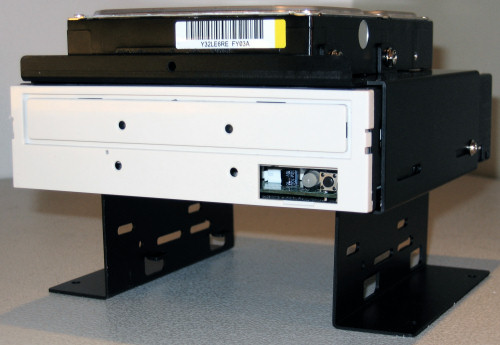
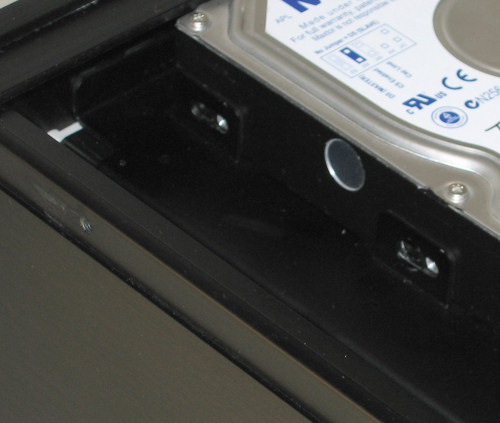
Other than our side-mounted IDE channel, the full-size ATX board fits without any problems. One snarl that we did run into, however, was that we had to remove the single 70mm exhaust fan before the motherboard could be laid down. This probably wouldn’t have been an issue had we installed the motherboard before the other components, but it wasn’t that big of a deal anyway.
The final steps of installing our video card and connecting all the cables were easy enough, thanks to the familiar layout and abundant space inside the Mstation. Even our rather large Golden Orb II cooler fits without problems. All in all, the install process in the HT-1100 is smooth, straight-forward, and simple.
In addition to the chassis, this case comes with a remote to control common routines in Windows Media Center Edition.
The remote has more than enough features to get the most out of your HTPC, and the cursor controller pad in particular has a nice layout for the best ease-of-use.



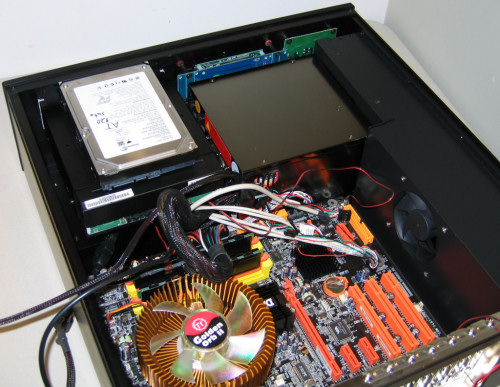
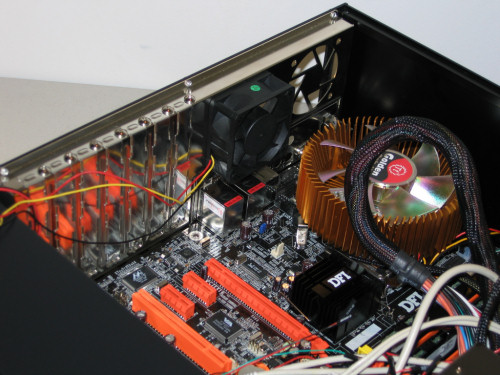
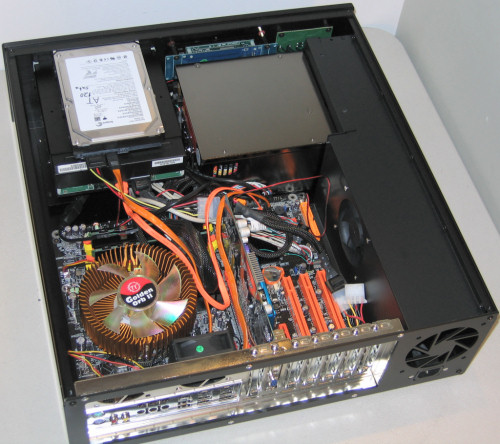










26 Comments
View All Comments
warped6 - Tuesday, November 22, 2005 - link
I purchased one of these back in the late spring. I too tried putting the DVD in the bottom position and it didn't fit. I then found out that it wasn't meant to hold an optical drive. It's meant to hold a VFD display so you can have the extra little door open to see the display. You can see this on there web site.Unless there is a short optical drive that I haven't found yet.I also replaced all of the fans with quieter ones. That helped quite a bit as far as noise.
I've been very happy with the box, now if I could just get the software to work the way I want it too and so the wife can deal with it, I could move it into the living room. :-)
bearxor - Tuesday, November 22, 2005 - link
I know a lot of people are complaining because you reviewed some fairly low-end HTPC cases, but these are all in the price range that I'm looking at, which is 90-130. I was settled on a Cooler Master case, but after reading what you guys wrote about the Tenor, I might just go with it. I had decided against it because of the blue LED lights, but like you said, I could just disconnect them.Not all of us are willing to spend 200-300 dollars on just a case for our HTPC, this review was for us.
bschuler2004 - Tuesday, November 22, 2005 - link
I still contend the best HTPC is a HTPC out of sight controlled via RF remote. Why even have a pc in the living room? Your cable company doesn't put it's Video On Demand servers in your living room.. why would you? It just doesn't make sense. Plus, then you can use any case, can be as loud as you want.. cuz nothing in the living room is as quiet as an Svideo,Rca, etc cable.. You save money, space, and alot of headaches.BigLan - Tuesday, November 22, 2005 - link
I agree, to a point. My HTPC is a generic mid-tower which has similar dimensions to my sub. It doesn't really look too out of place except fot the blue LED in the power supply.I've been thinking more and more that the ideal setup would be a non-descript PC box on the floor or hidden, with an external usb DVD drive (or two) and the remote control receiver placed near the amp/receiver.
Most of the current htpc cases seem to appeal to the bling factor, which I learned the hard way meant loud fans and inadequate cooling.
PDubya - Tuesday, November 22, 2005 - link
On page 5, the "removable cap" looks to be recessed, so I'm guessing you could place some filtration medium in that capped area. Just my two cents.Tamale - Tuesday, November 22, 2005 - link
but that's the exhaust.. I'm still not sure what good putting a filter on the exhaust side of the power supply would do...bldckstark - Tuesday, November 22, 2005 - link
I agree that putting a filter on the exhaust side would be useless, but the cover is there for some reason. I have several machines here at work that have covers very similar to this that are used for air intake filters. Was the PSU checked for air flow direction? Maybe they reversed it in this application.bldckstark - Tuesday, November 22, 2005 - link
The users manual states in the cooling section that you should not "block the air intake vents on the top panel, the front left side (at the filter) or the back (ventilated PCI slot covers." They are calling it an intake. This is the EC manual, not the US version. They are quite different, and there is no mention of the cover in the US version.http://www.antec.com/us/support_productInfo_detail...">EC users manual in English - pdf
Check page 6 under "Important Notes On Cooling"
UrQuan3 - Tuesday, November 22, 2005 - link
I understand that this review is geared more towards gaming rigs in the livingroom than for video recording/playback machines, still I'd like to know about some of those systems as well. I've been looking at picking up either an ATX P4 or a mini-ITX Pentium M machine from http://www.hushtechnologies.net/">Hush. Just wondering if anyone has tried one.OrSin - Tuesday, November 22, 2005 - link
500 is the low end of those case. They you pay extra for stuff like a reset buttom.Crazy over priced. I could see going as high $ or even alittle more if you want the front display, but $500+ ?. I guess if I spent $10,000 on Theathe systems it would not too bad. But $500 you could just hide a regular systems in the wall or something.